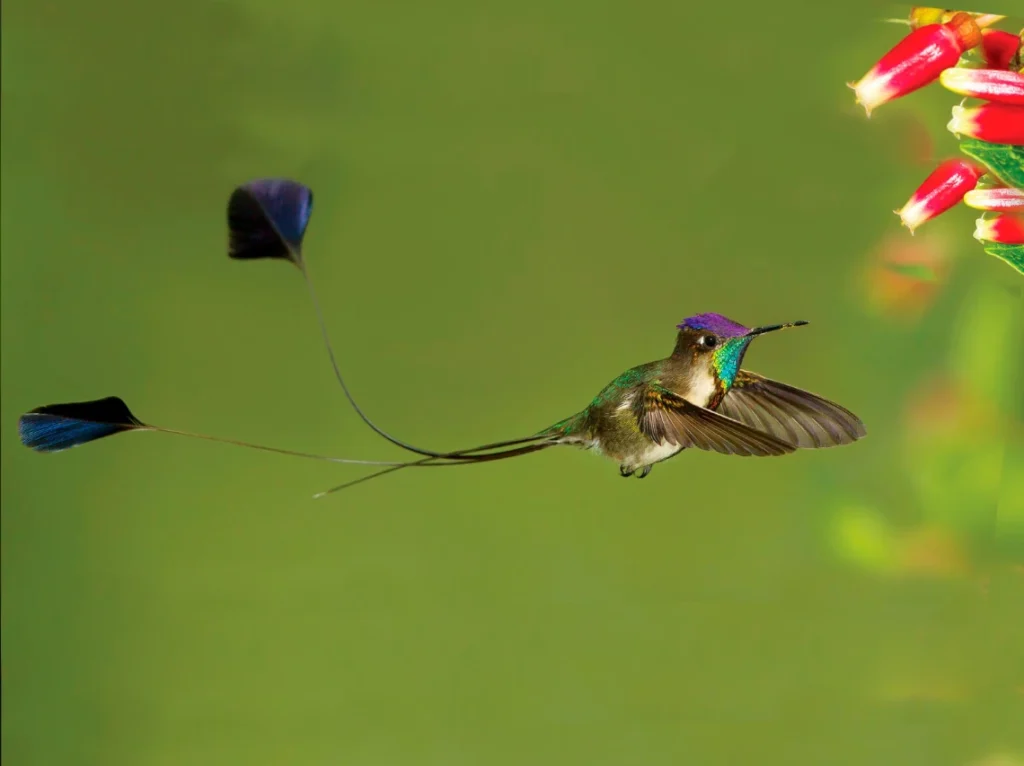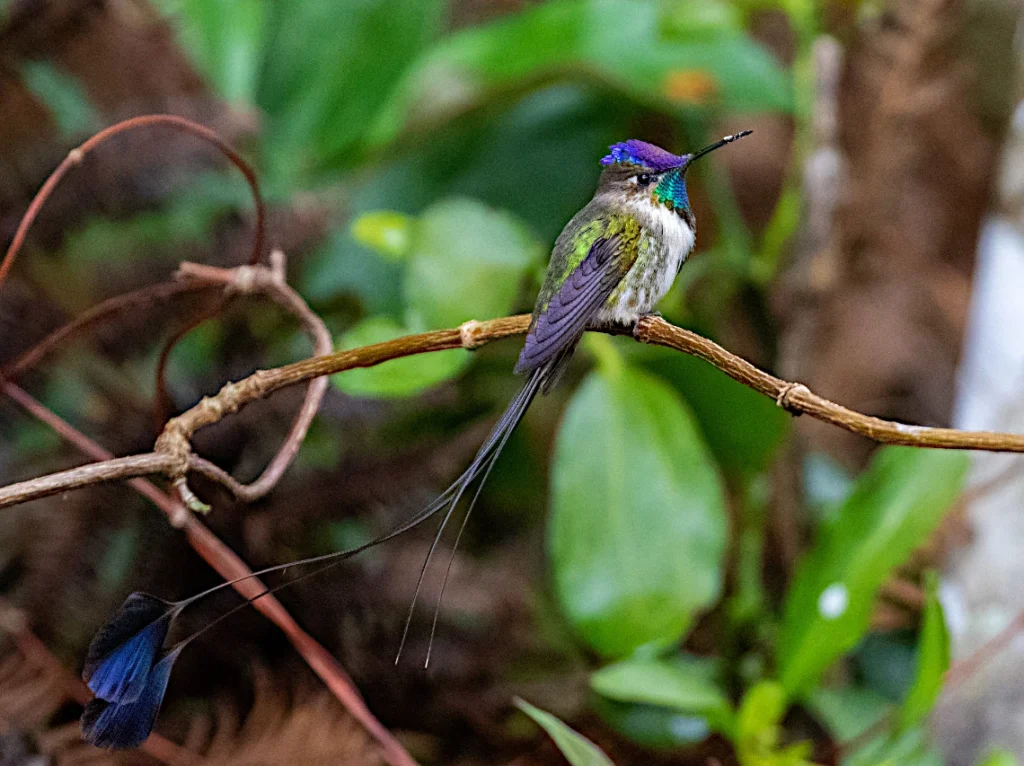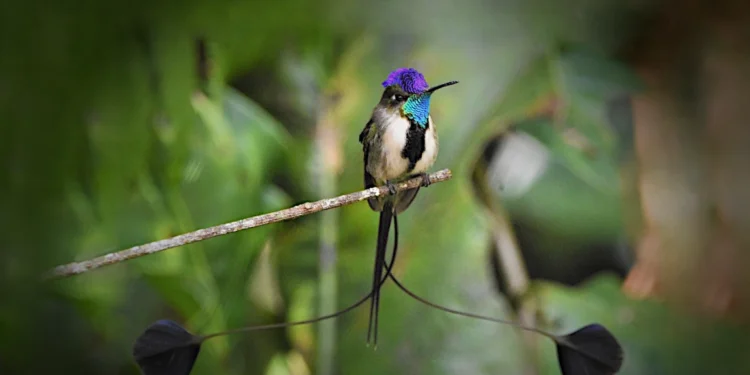This post is also available in:
Español
English
Tussen de bewolkte bergen van Peru, diep in de Andes, leeft een van de meest spectaculaire en exotische vogels ter wereld: de zwaardstaartkolibrie (Loddigesia mirabilis). Ook wel de “wonderkolibrie” genoemd, is deze soort een visueel spektakel die niet alleen verbijstert door zijn schoonheid, maar ook door zijn fascinerende kenmerken. Een exclusieve schat van Peru, die sinds zijn ontdekking in de 19e eeuw wetenschappers en vogelaars heeft gefascineerd. Met zijn elegante raketvormige staart en verblindende iriserende verenkleed is het moeilijk om niet betoverd te worden door de schoonheid en uniekheid van deze soort. In dit artikel verkennen we de meest verrassende eigenschappen van deze kolibrie, zijn habitat en zijn essentiële rol in het ecosysteem.
Een Vogel die Uniek en Exclusief is voor Peru
De zwaardstaartkolibrie is exclusief voor bepaalde regio’s van Peru, voornamelijk in de bewolkte bossen van de Upper Utcubamba Vallei, gelegen in het noordoosten van het land, in de provincies Luya en Chachapoyas, in het zuiden van de Amazonas-regio. Zijn habitat, op hoogtes tussen de 2000 en 2900 meter boven zeeniveau, biedt een unieke omgeving, gevuld met nectar-rijke bloemen die essentieel zijn voor zijn voeding en bestuiving.
Een Kleine Reus van de Natuur
Beschouwd als het kleinste gewervelde dier, is de kolibrie een wonder van de natuur. Zijn grootte is verbazingwekkend: hij is ongeveer 15 cm lang en weegt tussen de 40 en 70 gram. Maar laat je niet misleiden door zijn kleine formaat; deze vogels zijn ook zeer territoriaal en agressief tegenover andere vogels en soorten.
Kolibries staan bekend om hun indrukwekkende vliegvaardigheden, en de zwaardstaartkolibrie is geen uitzondering. Deze kleine vogels zijn de enige die achteruit kunnen vliegen, wat hen in staat stelt om met grote behendigheid te manoeuvreren terwijl ze nectar uit bloemen halen. Bovendien kunnen ze in de lucht blijven hangen in een statische positie, door hun vleugels tot wel 80 keer per seconde te slaan.
Bovendien hebben kolibries een uitzonderlijk gezichtsvermogen. Het is ontdekt dat ze meer kleuren kunnen zien dan mensen, waaronder ultraviolet tinten, wat hen helpt de meest voedzame bloemen te vinden, waarvan andere dieren niet kunnen profiteren. Kun je je voorstellen hoe ze de wereld zien?

De Wonderbaarlijke Wereld van de Zwaardstaart Kolibrie
Het mannetje van de zwaardstaartkolibrie is bijzonder opvallend. Met een heldere turquoise voorkop die van kleur verandert afhankelijk van het licht, een witte borst versierd met een zwarte band en vleugels van een schitterende koperkleur, is het duidelijk dat dit een unieke soort is. Zijn meest indrukwekkende kenmerk zijn echter zijn staartveren: hij heeft slechts vier veren in totaal, waarvan twee uitzonderlijk lang zijn, raketvormig, en eindigen in grote blauw-violette schijven, bekend als “spatula’s.” Deze veren zijn niet alleen mooi, maar spelen ook een essentiële rol in de voortplantingsrituelen.
Een Essentiële Rol in het Ecosysteem
De zwaardstaartkolibrie valt niet alleen op door zijn schoonheid, maar ook door zijn ongelooflijke uithoudingsvermogen. Zijn hart kan tot wel 700 keer per minuut kloppen, waardoor hij snel tussen de bloemen kan bewegen en de nectar verzamelt die essentieel is voor zijn overleving. Deze kolibrie is een cruciale bestuiver voor zijn ecosysteem: wanneer hij zich voedt met de nectar van planten, blijft het stuifmeel aan zijn veren of snavel hangen, wat kruisbestuiving vergemakkelijkt en bijdraagt aan de voortplanting van de planten in zijn omgeving.
De zwaardstaartkolibrie staat ook bekend als de “wonderkolibrie.”
Ontdekking en Documentatie
De zwaardstaartkolibrie werd voor het eerst beschreven in 1853 door de Britse natuuronderzoeker Andrew Matthews, die hem verzamelde voor de beroemde vogelverzamelaar George Loddiges, waarmee de wetenschappelijke naam van de soort, Loddigesia mirabilis, werd gegeven. Sinds zijn ontdekking heeft deze vogel de aandacht getrokken van natuuronderzoekers en natuurbeschermers vanwege zijn zeldzaamheid en verbluffende morfologie.
De Uitdagingen van Overleving
Hoewel het een natuurwonder is, staat de zwaardstaartkolibrie voor verschillende uitdagingen. Zijn habitat wordt bedreigd door ontbossing en de uitbreiding van de landbouw in de Peruaanse Andes, waardoor zijn verspreidingsgebied aanzienlijk is verkleind. Bovendien zijn zijn belangrijkste vijanden slangen, die een constant gevaar vormen voor deze kleine vogels.
Ondanks de uitdagingen hebben de schoonheid en ecologische waarde van de zwaardstaartkolibrie initiatieven voor natuurbescherming geïnspireerd. Lokale en internationale organisaties werken samen om zijn habitat in de bewolkte bossen van de Andes te beschermen. Natuurreservaten zoals Abra Patricia in de Amazonas-regio spelen een cruciale rol bij het behoud van deze soort.

Een Symbool van de Natuurlijke Schoonheid van Peru
De zwaardstaartkolibrie is niet alleen een symbool van de biodiversiteit van Peru, maar ook een herinnering aan de kwetsbaarheid van de Andes-ecosystemen. Deze kleine maar majestueuze vogel blijft degenen verbazen die het geluk hebben hem in zijn natuurlijke omgeving te zien, en zijn behoud is van vitaal belang om ervoor te zorgen dat toekomstige generaties hem kunnen blijven bewonderen. Als je ooit de kans krijgt om de bewolkte bossen in het noorden van Peru te bezoeken, ben je in een van de weinige plekken ter wereld waar je het voorrecht hebt deze gevleugelde wonder in zijn natuurlijke habitat te zien.
Was je verrast door de schoonheid en uniekheid van de zwaardstaartkolibrie? Of heb je ooit deze prachtige zwaardstaartkolibrie gezien? Deel je ervaringen met deze wonderbaarlijke vogel, laat een reactie achter! We moedigen je ook aan om dit artikel op je sociale media te delen en je te abonneren voor meer fascinerende inhoud over de biodiversiteit en curiositeiten van Peru.







